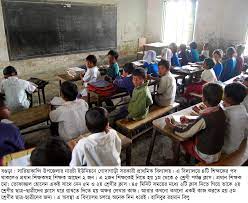Bangladesh new school curriculum: A great opportunity or a looming disaster?

Dr Manzoor Ahmed :
The new curriculum and accompanying textbooks are being followed in Class 1 and 2 as well as Class 6 and 7, and will be introduced in phases from pre-primary to Class 12 by 2027. The ambitious aim is to equip the new generation with relevant skills and competencies for the 21st century, weaning them away from memorising guidebooks and relying on private tutors and coaching centres to pass tests without real learning.
A circular of National Curriculum and Textbook Board posted (NCTB) on its website titled “Do not be confused by false propaganda about the new curriculum,” says the curriculum is aimed at producing “smart citizens” for Smart Bangladesh, to be realised by 2041. The draft of the curriculum, it says, was prepared based on six studies, review of curricula of other countries and exchange of views with over 800 “stakeholders.” The new system, it affirmed, would lead to “students studying more than before, actively engaged in learning, doing and presenting group work, acquiring not just knowledge, but also skills.” There will be half-yearly and annual examinations, but “without the fear about it.” Still, there will be pass and fail in examinations, the circular assures, but also report cards with a 7-point scale. And there will be no need for private tutoring, coaching centres, and guidebooks and notebooks.
It appears that a few “experts” have succeeded in using their ill-digested knowledge of learning theory and practice to persuade decision-makers to begin an experiment with children as guinea pigs. Singapore and Finland, boasting the highest performing schools in the world with highly paid professionals as teachers, who enjoy great autonomy in how they conduct their classes, may come close to the ideal pedagogy our experts seem to have in mind. Even these countries have not given up grading and sorting students by performance. Our education minister has been badly advised and a heavy price is likely to be paid by our children—with their education put in jeopardy.
Why did the earlier experiments fail and had to be abandoned? It was not because the intent of the authorities, the objectives of the initiatives or the theoretical justification for the public examinations and the creative questions (structured questions based on Bloom’s taxonomy of knowledge used in many countries) were wrong.
Despairing of the poor results in school, students and parents did what they could. They relied on guidebooks and notebooks providing “creative answers” to be memorised. They went to private tutors and coaching centres. Poorly paid teachers and sharp entrepreneurs took advantage of the situation. A “shadow education” industry saw rapid growth.
We may be witnessing a deja vu with the new curriculum. The conditions that hobbled past well-intentioned initiatives have not changed much. Moreover, a haphazard trial with parts of the new curriculum was undertaken in 2022, when schools re-opened after the long Covid-induced closure. The selection of trainers and their training to help roll out the major change in pedagogy has been done in haste. The time allowed for in-person training and orientation of classroom teachers was reduced from weeks to days, and even this could not be implemented for all teachers. The rollout of a major educational reform has all the hallmarks of how this should not be done.
Not that the authorities have not been warned of the dangers. Education watch reports for the recent three years and public discussions have urged prioritising recovering from the learning losses due to the Covid closure of schools and other preexisting problems aggravated further by the pandemic. They recommended holding off a major reform. Decision-makers have not listened to such advice.
We have serious structural problems with how curriculum development and implementation is handled. Such an initiative cannot be done properly by taking it on at an interval of a decade or as an ad-hoc activity. Educationally advanced countries have permanent autonomous bodies with professionals engaged in research, development, trial, evaluation and capacity building for continuous work on curriculum, syllabus, learning content and assessment. An example is the National Council for Educational Research and Training (NCERT), an institution with a university status in India responsible for curriculum and textbook development for school education.
The structural problem needs attention, but more urgent action is needed on the quandary we face now. A failed experiment this time will have a larger consequence for the future of children than in the past, because the changes proposed are of broader scope. To avert a looming disaster, the decision-makers need to go back to the drawing board. They need to consider the realities in respect of teachers, schools and students’ circumstances, and try to match reform objectives with the capacity of the majority of schools to deliver the results.
Stephen Heyneman, professor emeritus at Vanderbilt University in the US, who is knowledgeable about Bangladesh, wrote in a recent personal communication to this writer that the source of the problem rests in the inability to understand the exigencies of the classroom—the lack of materials, the illness of students, the idiosyncrasies of electricity supply, the wide variation in student abilities and interest, etc. So the standard curricula are first vilified, then discarded and replaced with an ideal “modern curricula” that is difficult to implement.
The ambitions of the new curriculum are commendable, but aiming too high too fast without creating the essential conditions for success is extracting a high price by endangering our children’s future.
Dr Manzoor Ahmed is professor emeritus at Brac University, chair of Bangladesh ECD Network (BEN), and adviser to the Campaign for Popular Education (CAMPE).
Daily Star











